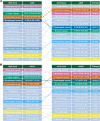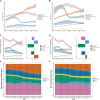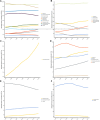Burden of gastrointestinal cancers in Asia, 1990-2019
- PMID: 40200145
- PMCID: PMC11980333
- DOI: 10.1186/s12876-025-03824-z
Burden of gastrointestinal cancers in Asia, 1990-2019
Abstract
Objectives: Gastrointestinal (GI) cancers are a major cause of morbidity and mortality worldwide. However, there has been no comprehensive assessment of GI cancers in Asia.
Study design: This was an epidemiological study.
Methods: The study calculated the incidence and deaths of six common GI cancers in Asia between 1990 and 2019 using data from the Global Burden of Disease study. The data are presented by sex, age, year, location, and risk factors, and are shown as counts and rates.
Results: In 2019, the age-standardized incidence rates (ASIR) for colorectal, esophageal, gallbladder and biliary tract (GBTC), liver, pancreatic, and stomach cancers were 23.88, 8.24, 2.77, 7.97, 5.41, and 19.77, respectively. The age-standardized death rates (ASDR) for colorectal, esophageal, GBTC, liver, pancreatic, and stomach cancers were 12.49, 7.73, 2.53, 7.22, 5.47, and 14.67, respectively. From 1990 to 2019, there was an increasing trend in incidence and deaths for esophageal, liver, and stomach cancer, while a decreasing trend was observed in colorectal, GBTC, and pancreatic cancer. The burden of GI cancer increased successively in older generations and was higher in males than in females. Furthermore, this burden varied significantly across Asian subregions and countries. Dietary risks, smoking, alcohol use, and high BMI contribute to GI cancer mortality.
Conclusions: GI cancers continue to be the primary contributor to the tumor burden in Asia, with increasing absolute numbers but varying age-standardized measures over the past three decades.
Keywords: Asia; Death; Gastrointestinal cancer; Global burden of disease study; Incidence.
© 2025. The Author(s).
Conflict of interest statement
Declarations. Ethics approval and consent to participate: Not applicable. Consent for publication: Not Applicable. Competing interests: The authors declare no competing interests.
Figures





Similar articles
-
Trends in incidence and mortality of early-onset gastrointestinal cancers: a comprehensive study.BMC Gastroenterol. 2025 Jun 2;25(1):424. doi: 10.1186/s12876-025-04015-6. BMC Gastroenterol. 2025. PMID: 40457201 Free PMC article.
-
Southeast Asia burden and trend of Gastrointestinal tract cancers from 1990 to 2021 and its prediction to 2050: findings from the Global Burden of Disease Study 2021.Int J Colorectal Dis. 2025 Mar 8;40(1):60. doi: 10.1007/s00384-025-04849-2. Int J Colorectal Dis. 2025. PMID: 40056174 Free PMC article.
-
Global Burden of 5 Major Types of Gastrointestinal Cancer.Gastroenterology. 2020 Jul;159(1):335-349.e15. doi: 10.1053/j.gastro.2020.02.068. Epub 2020 Apr 2. Gastroenterology. 2020. PMID: 32247694 Free PMC article.
-
Epidemiology of gastrointestinal and liver tumors.Eur Rev Med Pharmacol Sci. 2010 Apr;14(4):249-58. Eur Rev Med Pharmacol Sci. 2010. PMID: 20496531 Review.
-
Evolving landscape of colorectal cancer: Global and regional burden, risk factor dynamics, and future scenarios (the Global Burden of Disease 1990-2050).Ageing Res Rev. 2025 Feb;104:102666. doi: 10.1016/j.arr.2025.102666. Epub 2025 Jan 18. Ageing Res Rev. 2025. PMID: 39828028 Review.
Cited by
-
Global burden of early-onset gallbladder and biliary tract cancer from 1990 to 2021.BMC Gastroenterol. 2025 Jul 1;25(1):461. doi: 10.1186/s12876-025-04080-x. BMC Gastroenterol. 2025. PMID: 40597693 Free PMC article.
-
Research trends and visualization analysis of autoimmune disease-related liver cancer from 2004 to 2024: a bibliometric study.Discov Oncol. 2025 Jul 1;16(1):1198. doi: 10.1007/s12672-025-03042-9. Discov Oncol. 2025. PMID: 40591043 Free PMC article.
References
-
- Siegel RL, Miller KD, Wagle NS, Jemal A. Cancer statistics, 2023. CA Cancer J Clin. 2023;73(1):17–48. - PubMed
-
- Withrow DR, Nicholson BD, Morris EJA, Wong ML, Pilleron S. Age-related differences in cancer relative survival in the United States: A SEER-18 analysis. Int J Cancer. 2023;152(11):2283–91. - PubMed
-
- Sugranes TA, Flanagan M, Thomas C, Chang VY, Walsh M, Cunniff C. Age of first cancer diagnosis and survival in Bloom syndrome. Genet Med. 2022;24(7):1476–84. - PubMed
-
- Sung H, Ferlay J, Siegel RL, Laversanne M, Soerjomataram I, Jemal A, et al. Global Cancer Statistics 2020: GLOBOCAN Estimates of Incidence and Mortality Worldwide for 36 Cancers in 185 Countries. CA Cancer J Clin. 2021;71(3):209–49. - PubMed
MeSH terms
LinkOut - more resources
Full Text Sources
Miscellaneous

